Brown Line (CTA)
| Brown Line | |
|---|---|
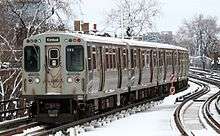 A Brown Line train of 3200 series cars. | |
| Overview | |
| Type | Rapid transit |
| System | Chicago "L" |
| Status | Operational |
| Locale | Chicago, Illinois, United States |
| Termini |
Kimball The Loop, Belmont |
| Stations | 27 |
| Daily ridership | 101,881 (avg. weekday in 2011)[1] |
| Operation | |
| Opened | August 1, 1949 (Current operation) |
| Operator(s) | Chicago Transit Authority |
| Character | Elevated and Street Level |
| Rolling stock | 3200-series |
| Technical | |
| Line length | 11.4 mi (18.3 km) |
| Track gauge | 4 ft 8 1⁄2 in (1,435 mm) |
| Minimum radius | 90 feet (27 m) |
| Electrification | Third rail, 600 V DC |
The Brown Line (or the Ravenswood Line) of the Chicago "L" system, is an 11.4-mile (18.3 km) route with 27 stations between Chicago's Albany Park neighborhood and downtown Chicago. It runs completely above ground and is almost entirely grade-separated. It is the third busiest 'L' route, with an average of 101,881 passengers boarding each weekday in 2011.[1]
The Brown Line operates to the Loop weekdays and Saturdays from 4:00 am to 1:30 am and on Sundays from 5:00 am to 1:30 am. The Brown Line Shuttle service, running only between Kimball and Belmont, runs from 4:00 am to 2:20 am on weekdays and Saturdays, and 5:00 am to 2:00 am on Sundays. At Belmont, southbound riders can transfer to the 24-hour Red Line.
Before CTA lines were color-coded in 1993, the Brown Line was known as the Ravenswood Route; specifically, the series of stations from Belmont to Kimball were called the Ravenswood branch. Accordingly, the Kimball-Belmont shuttle service was called the Ravenswood Shuttle.
Operation


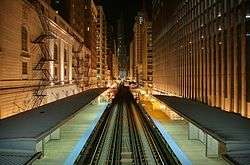
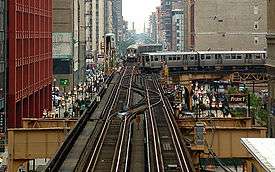
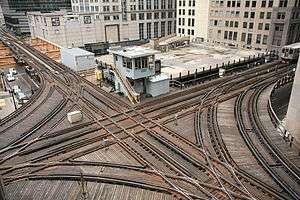
The Brown Line begins on the northwest side of Chicago, at the Kimball terminal in Albany Park, where there is a storage yard and servicing shop for the trains to the east of the passenger station. From there, trains operate over street level tracks between Leland and Eastwood Avenues to Rockwell Street, then ramp up to the elevated structure for the rest of the trip.
The trains on the street-level section are powered by third rail rather than overhead catenary (the technology used by most other U.S. electric-powered at-grade rail systems), a decision that exposes wayward pedestrians to the risk of electrocution. A fatal accident in 1977 involving a severely intoxicated Korean immigrant who attempted to urinate on the third rail at the Kedzie station eventually resulted in a famous Illinois Supreme Court decision in 1992 affirming a verdict of $1.5 million against CTA.[2]
After the Damen station, the route turns south, about one-half block parallel and west of Metra's Union Pacific North railroad line and Ravenswood Avenue to a point south of the Addison station. Here the route turns east again and runs parallel to Roscoe Street past Sheffield Avenue where it once again turns south at Clark Junction to join the four-track North Side elevated line in Lakeview. From just north of Belmont station south to Armitage, Brown and Red Line trains operate side-by-side, with Purple Line Express trains sharing the tracks with the Brown Line during weekday rush hours. Brown and Purple Line trains run on the outermost tracks serving five stops, while Red Line trains run on the innermost tracks making only two stops.
South of the Armitage station, Brown and Purple Line trains continue southward towards the Chicago Loop on elevated tracks which zigzags its way through the neighborhoods of Lincoln Park and Near North Side stopping at Sedgwick and Chicago/Franklin. Running over Franklin, then Wells Street, a stop is made at the Merchandise Mart before crossing the Chicago River on the upper level of the Wells Street Bridge before joining the Loop Elevated at Lake Street. Operating counterclockwise, Brown Line trains operate around the Loop on the Outer track via Wells-Van Buren-Wabash-Lake, serving all Loop stations, before the return trip back north to the Kimball terminal.
Rolling stock
The Brown Line is operated with the Morrison-Knudsen-built 3200-series railcars, delivered from 1992 through 1994, with one 2600-series railcar 3458, (renumbered from 3032). 2600-series railcars sometimes appear on the Brown Line when there is a shortage of 3200-series cars. However, the borrowing of 2600-series cars is no longer necessary as of December 2012 since Orange Line-assigned 2400-series cars (often in mixed eight car consists with that line's 3200-series cars) began operating selected weekday rush hour trips on the Brown Line due to a shortage in storage space at the Kimball Yard. The Orange Line's 2400-series cars have since been replaced by the 2600-series cars as of October 31, 2014. Still, one 2600-series car 3458, (renumbered from 3032) remains on the Brown Line. The Brown Line operate using four cars at other times on weekdays and all day on weekends and eight cars during weekday rush hours. The Brown Line's 3200-series cars are expected to remain in service on the line until at least the 2020s, where they will be replaced by the future 7000-series cars if all options are picked up, otherwise the Brown Line's 3200-series cars will remain in service on the line until the 2030s if the options are not picked up. In the meantime, CTA is currently in the process of overhauling the 3200-series cars with color LED destination signs (similar to the 5000-series cars), new air conditioning systems, and rebuilt propulsion systems, passenger door motors, and wheel/axle assemblies. The 3200-series rehabilitation began in 2015 and will be completed in 2017.
Beginning March 30, 2008, the Brown Line began running eight cars during rush hours, since all of the reopened or renovated stations have been rebuilt to accommodate eight cars.[3] Prior to this, although ridership certainly warranted eight cars on the Brown Line during weekday rush hours, most stations on the line couldn't berth longer than six cars. Six cars are standard on the Brown Line during midday. Early morning, late evening, and weekend service is generally provided by four cars, although this may be extended to eight cars due to special events and holidays.
History
The Northwestern Elevated Railroad opened the Ravenswood branch between the existing main line and Western Avenue in Lincoln Square on May 18, 1907.[4] The route was completed to the Kimball terminal on December 14, 1907.[5]
The Kimball terminal was completely renovated and a new bridge over the North Branch of the Chicago River was completed in the 1970s. The Western and Merchandise Mart stations were rebuilt in the 1980s. Prior to the start of the Brown Line Capacity Expansion Project, these two stations, along with the Kimball terminal were the only ADA accessible stations on the Brown Line outside of the Loop.
Brown Line Capacity Expansion Project

The Brown Line Capacity Expansion Project—which ran from 2006 to 2009—was undertaken to repair aging infrastructure and increase passenger capacity at Brown Line stations.[6] On February 20, 2006, the CTA broke ground on the project. All but one of the Brown Line stations were reconstructed to be ADA compliant and to accommodate eight-car trains. The right-of-way between Kimball and Rockwell Avenue was modernized. Traction power equipment and train control systems were upgraded and a new fiber optic communication network installed. Merchandise Mart was the only station not to receive any work as it had previously been reconstructed from 1987 to 1988, and was already ADA compliant and able to accommodate 8-car trains. Another two stations—Kimball and Western—received small platform extensions but little other work, and the other 16 stations were completely rebuilt.[7]
The first two stations to be completed—Kedzie and Rockwell—reopened on August 16, 2006,[8] and all of the stations had reopened by July 30, 2009 when the new Wellington station entered service.[9] The project was completed on December 31, 2009.[10]
Station listing

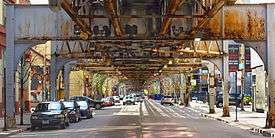
| Ravenswood Branch | |||
|---|---|---|---|
| Station | Location | Transfers | Points of Interest & Notes |
| Kimball |
4755 N. Kimball Avenue | - | Albany Park, Northeastern Illinois University, Northside College Prep, Albany Park Library |
| Kedzie |
4648 N. Kedzie Avenue | — | Albany Park, North Park University, Theodore Roosevelt High School, Swedish Covenant Hospital |
| Francisco |
4648 N. Francisco Avenue | — | Lincoln Square, Stephen Tyng Mather High School |
| Rockwell |
4648 N. Rockwell Street | — | Lincoln Square, Ravenswood Manor Historic District |
| Western |
4648 N. Western Avenue | — | Lincoln Square, Sulzer Regional Library, Krause Music Store, Old Town School of Folk Music |
| Damen |
4645 N. Damen Avenue | Ravenswood, Amundsen High School, Rosehill Cemetery, St. Gregory the Great High School
Transfer to Metra trains at Ravenswood | |
| Ravenswood | 4530 N. Ravenswood Avenue | — | Closed August 1, 1949 |
| Montrose |
1817 W. Montrose Avenue | — | Ravenswood, Kinetic Playground, All Saints Episcopal Church |
| Irving Park |
1816 W. Irving Park Road | — | Ravenswood, Lake View High School, Graceland Cemetery, St. Benedict High School |
| Addison |
1818 W. Addison Street | — | North Center, DePaul College Prep, WGN-TV Station, Lane Technical College Prep High School |
| Paulina |
3410 N. Lincoln Avenue | — | Lakeview, Electrical Audio Recording Facility |
| Southport |
3411 N. Southport Avenue | — | Lakeview, Music Box Theatre, Theatre Building Chicago |
| North Side Main Line | |||
| Belmont |
945 W. Belmont Avenue | Red Line Purple Line |
Lakeview, Briar Street Theater, Boystown, The Vic Theatre
Transfer to Red and Purple Line Express trains |
| Wellington |
945 W. Wellington Avenue | — | Lakeview, The Alarm, Signal of Peace, Illinois Masonic Medical Center |
| Diversey |
943 W. Diversey Avenue | — | Lincoln Park, Apollo Theatre Chicago, Brewster Apartments, Wiggly Field, Francis J. Dewes House |
| Wrightwood | Wrightwood Street and Lincoln/Sheffield Avenues | — | Closed August 1, 1949 |
| Fullerton |
943 W. Fullerton Avenue | Red Line Purple Line |
Lincoln Park, DePaul University, Children's Memorial Hospital, St. Josaphat Roman Catholic Church, Biograph Theater |
| Webster | 945 W. Webster Avenue | — | Closed August 1, 1949 |
| Armitage |
944 W. Armitage Avenue | — | Goose Island Brewery, Lincoln Park Zoo |
| Willow | Willow Street and Sheffield Avenue | — | Closed May 17, 1942 |
| Halsted | — | Closed August 1, 1949 | |
| Larrabee | 1540 N. Larrabee Street | — | Closed August 1, 1949 |
| Sedgwick |
1536 N. Sedgwick Street | — | The Second City, Piper's Alley, Old Town, Chicago History Museum, North Avenue Beach, Steppenwolf Theatre Company |
| Schiller | — | Closed August 1, 1949 | |
| Division | — | Closed August 1, 1949 | |
| Oak | Oak Street and Orleans Street | — | Closed July 31, 1949 |
| Chicago |
301 W. Chicago Avenue | — | Moody Bible Institute, Cabrini–Green, River North Gallery District |
| Grand | Grand Avenue and Franklin Street | — | Closed September 20, 1970 |
| Kinzie | Kinzie Street and Wells Street | — | Closed 1921; replaced by Grand |
| Merchandise Mart |
350 N. Wells Street | Purple Line | Merchandise Mart
Transfer station for Purple Line |
| The Loop (Counterclockwise) | |||
| Randolph/Wells | 150 N. Wells St. | — | Closed July 17, 1995; partially demolished and replaced by Washington/Wells |
| Washington/Wells |
100 N. Wells Street | Pink Line Purple Line Orange Line |
Chicago City Hall, Civic Opera House, Chicago Mercantile Exchange, Ogilvie Transportation Center |
| Madison/Wells | 1 N. Wells St. | — | Closed January 30, 1994; demolished and replaced by Washington/Wells |
| Quincy |
220 S. Wells Street | Pink Line Purple Line Orange Line |
Willis Tower (formerly Sears Tower), Union Station
Transfer station for Amtrak trains |
| LaSalle/Van Buren |
121 W. Van Buren Street | Chicago Board of Trade, Chicago Board Options Exchange, LaSalle Street Station | |
| Dearborn/Van Buren | Dearborn Street and Van Buren Street | — | Closed 1949 |
| Harold Washington Library–State/Van Buren |
1 W. Van Buren Street | Pink Line Purple Line Orange Line Red Line Blue Line |
Harold Washington Library Center, DePaul University, Robert Morris University, John Marshall Law School, Chicago Bar Association and The Auditorium Building of Roosevelt University |
| State/Van Buren | 400 S. State St. | — | Closed September 2, 1973 |
| Adams/Wabash | 201 S. Wabash Avenue | Green Line Pink Line Purple Line Orange Line |
Grant Park, Petrillo Music Shell, Buckingham Fountain, Art Institute of Chicago, Orchestra Hall, DePaul University |
| Madison/Wabash | 2 N. Wabash Avenue | Closed March 16, 2015 | |
| Washington/Wabash | TBD | — | Consolidation of Madison/Wabash and Randolph/Wabash scheduled to open in 2017 |
| Randolph/Wabash |
151 N. Wabash Avenue | Marshall Field's, Chicago Cultural Center, Millennium Park, Millennium Station | |
| State/Lake | 200 N. State Street | Red Line | Chicago Theatre, Gene Siskel Film Center, Harold Washington College
Transfer station for Red Line |
| Clark/Lake |
100 W. Lake Street, Chicago | Green Line Pink Line Purple Line Orange Line |
James R. Thompson Center, Richard J. Daley Center |
- Note: After stopping at Clark/Lake, Brown Line trains return to Merchandise Mart, then make all stops back to Kimball.
References
- 1 2 "Annual Ridership Report: Calendar Year 2011" (PDF). Chicago Transit Authority. Retrieved 2012-05-31.
- ↑ Lee v. Chicago Transit Authority, 152 Ill.2d 432, 605 N.E.2d 493 (1992).
- ↑ Press Release - Eight Car Service to Begin on Brown Line. transitchicago.com.
- ↑ "New 'L' Line Operated". Chicago Daily Tribune. 19 May 1907.
- ↑ Borzo, Greg (2007). The Chicago "L". Arcadia Publishing. p. 133. ISBN 978-0-7385-5100-5.
- ↑ Brown Line Capacity Expansion Project. ctabrownline.com
- ↑ "Chicago L.org: Operations - Lines -> Brown Line".
- ↑ Rockwell station, ctabrownline.com
- ↑ http://www.transitchicago.com/news/default.aspx?Month=&Year=&Category=2&ArticleId=2437
- ↑ "Countdown To A New Brown - The Brown Line Capacity Expansion Project".
External links
- About the Brown Line at Countdown to a New Brown - official CTA site
- Brown Line at Chicago-L.org
- Train schedules at CTA official site